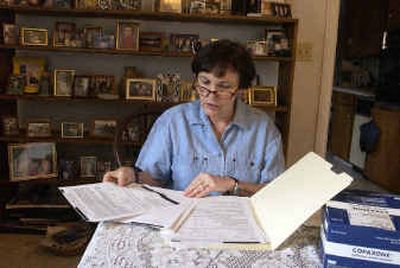Medicare coverage left up to lottery

Rita Callery, of Lewiston, controls her multiple sclerosis by giving herself a daily injection of Copaxone. The drug costs her $1,028 a month.
Callery, 53, plans to put her name in a new Medicare lottery. If she wins, she’ll get help paying for Copaxone. If her name is not drawn at random, she’ll continue paying full price for a drug she really can’t afford.
When she became eligible for Medicare this year, she dropped her private insurance, which had paid 80 percent of her drug costs after a $3,000 deductible. Medicare pays nothing for the drug.
“You’d think our country could do it better,” said Callery, who works part time directing court-appointed advocates for children. She doesn’t consider herself a particularly lucky person, although she found a shiny penny this week. “I’ve never won the lottery. I’ve won coloring contests when I was 6 years old.”
Last year’s Medicare Modernization Act set aside $500 million to help 50,000 people pay for certain drugs that can be administered at home.
These newer “niche drugs” for cancer, MS, rheumatoid arthritis, hepatitis C and other serious illnesses will be covered at rates from 75 percent to 90 percent.
Patients like Callery must submit a lengthy application by Sept. 30, including a portion signed by their doctor. A random drawing will determine who gets the coverage. People who apply by Aug. 16 will be in an early drawing that will allow coverage to start Sept. 1.
The winners will represent a small portion of the estimated 500,000 to 600,000 Medicare beneficiaries nationwide thought to be paying for the drugs without other insurance coverage. Medicare is the federal health plan for people over age 65; the program also covers some people with disabilities like Callery.
Patient advocacy groups say the benefit is too small but better than nothing. The groups have been lobbying for years for coverage of drugs that replace older Medicare-covered therapies that could only be administered in a doctor’s office.
“Science had taken us to a place where there were more and more cancer drugs in oral form,” said Wendy Selig, vice president for legislative affairs for the American Cancer Society in Washington, D.C. “It didn’t make sense for Medicare to cover some chemotherapy drugs and not others.”
For years, Spokane attorney John P. Lynch has been lobbying Congress for better coverage for certain arthritis drugs. At age 56, he’s not eligible for Medicare himself, but he gets some relief from his rheumatoid arthritis by giving himself a weekly injection of Enbrel. The drug costs more than $12,000 a year.
“Without Medicare coverage, I don’t think I will be able to afford Enbrel when I retire,” he said. “The only reason I can now is because I have private insurance.”
He resents the politics that pits cancer patients against rheumatoid arthritis patients for limited dollars.
“RA and cancer patients should not be forced into a lottery,” he said. “Rather, both should have the full benefit of the law.”
Dr. Stephen Anthony, research director at Spokane’s Cancer Care Northwest, called the program “a half-billion dollar giveaway for pharma (the pharmaceutical industry).”
The Medicare lottery, Anthony said, doesn’t address the real issue: the prohibitive cost of niche drugs. He compared the situation with the Titanic approaching an iceberg. “The iceberg is drug costs. Let’s steer the ship away from the iceberg instead of getting people into a limited number of lifeboats.”
In some cases, the lottery price reduction can’t beat what’s already offered by drug company assistance programs, Anthony said. Patients on Gleevec, a niche cancer drug covered in the lottery, would be better off financially staying in an assistance program offered by the drug company Novartis, Anthony said. In addition, the Medicare price reductions are based on “average wholesale price,” which few patients pay, he said.
The lottery coverage ends in 2006 when coverage will be taken over by the new Medicare drug benefit. At that time, those who choose to join the Medicare drug plan (which will require a monthly premium, a deductible and co-pays) will get the coverage.
Drugs covered by the lottery include:
“ Humira, Kineret and Enbrel for rheumatoid arthritis.
“ Copaxone, Rebif, Avonex and Betaseron for multiple sclerosis.
“ Miacalcin (nasal) for osteoporosis.
“ Tracleer for pulmonary hypertension.
“ Hectoral for secondary hyperparathyroidism.
“ Fosamax and Actonel for Paget’s disease.
“ Pegasysa and PEG-Intron for hepatitis C.
“ Valganciclovir for CMV retinitis.
“ Targretin for cutaneous T-cell lymphoma.
“ Iressa for non-small cell lung cancer.
“ Hexalen for epithelial ovarian cancer.
“ Gleevec for chronic myelogenous lymphoma and GI stromal tumor.
“ Temodar for anaplastic astrocytoma.
“ Thalomid for multiple myeloma.
“ Arimidex, Aromasin, Femara, Nolvadex and Fareston for stage 2-4 breast cancer.
Groups such as the American Cancer Society and the Arthritis Foundation are contacting members to get the word out about the lottery. They also will keep lobbying.
“The Arthritis Foundation won’t be satisfied until everybody has coverage on these therapies,” said Kevin Brennan, of the arthritis group in Washington, D.C.